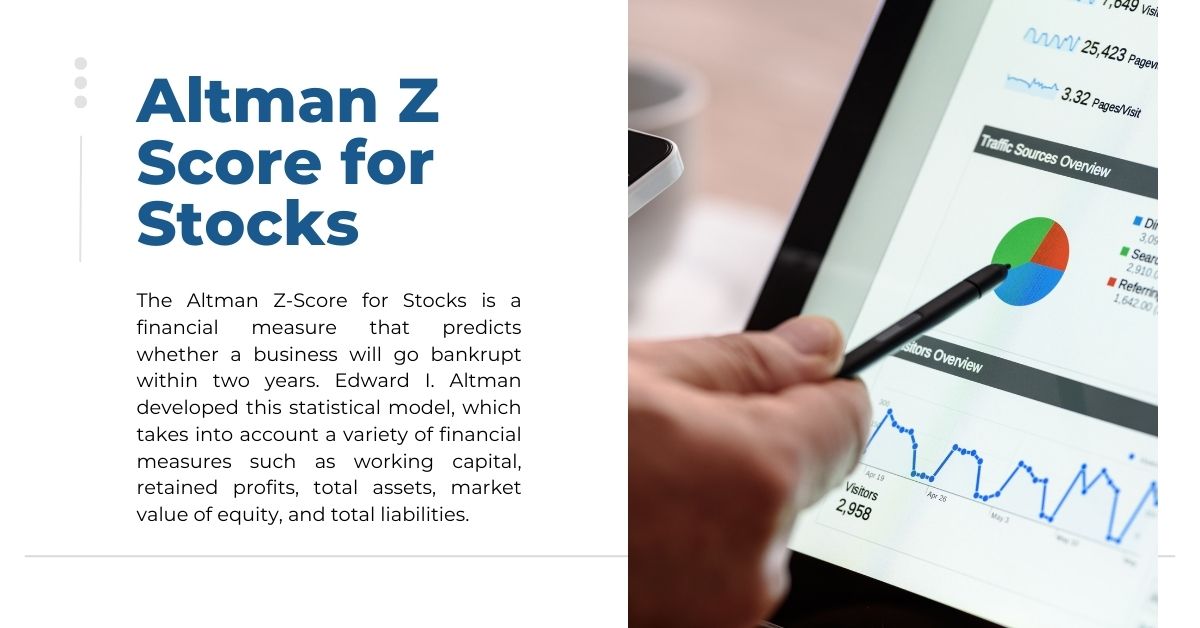The Altman Z-Score is a financial measure that predicts whether a firm will go bankrupt. This statistical model developed by Edward Altman in the late 1960s, assesses a company’s financial health using a variety of financial variables.
Understanding the Altman Z-Score allows investors to make better selections about which stocks to invest in and which to avoid. In this blog article, we’ll look at the components of the Altman Z-Score, how to calculate it, and what the various scores mean.
What is Altman Z Score for Stocks?

The Altman Z-Score for Stocks is a financial measure that predicts whether a business will go bankrupt within two years. Edward I. Altman developed this statistical model, which takes into account a variety of financial measures such as working capital, retained profits, total assets, market value of equity, and total liabilities.
By merging these criteria into a single calculation, the Altman Z-Score calculates a numerical score that represents the company’s financial health and chance of bankruptcy. A higher Z-Score implies a lesser probability of bankruptcy, whereas a lower Z-Score indicates a larger risk.
How to Calculate the Altman Z Score?
The Altman Z-Score is calculated using the following formula:
Z = 1.2A + 1.4B + 3.3C + 0.6D + 1.0E
Where:
- A: Working capital / Total assets
- B: Retained earnings / Total assets
- C: EBIT / Total assets
- D: Market value of equity / Total liabilities
- E: Sales / Total assets
Once you have calculated the Z-Score, you can interpret it as follows:
- Z > 2.99: Low probability of bankruptcy
- 1.81 < Z < 2.99: Gray area, moderate probability of bankruptcy
- Z < 1.81: High probability of bankruptcy
It’s important to note that the Altman Z-Score is a predictive model and should be used in conjunction with other financial analysis tools. Additionally, the model may not be as accurate for certain industries or companies.
If you want to read in detail about financial ratios, you can also read these articles:
- Working Capital to Sales Ratio: A Deeper Dive into Financial Efficiency
- Debt to Profit: A Risky Game or a Strategic Move?
- Market Cap to Sales: The Ultimate Guide to Valuing Growth Stocks
Example of Altman Z Score
Let’s consider a company, “Tech Innovations Ltd.” The company’s financial data for the most recent fiscal year is as follows:
- Working Capital: ₹100 crore
- Total Assets: ₹500 crore
- Retained Earnings: ₹50 crore
- EBIT: ₹75 crore
- Market Value of Equity: ₹300 crore
- Total Liabilities: ₹200 crore
- Sales: ₹400 crore
Calculation:
Using the Altman Z-Score formula:
- A: 100/500 = 0.2
- B: 50/500 = 0.1
- C: 75/500 = 0.15
- D: 300/200 = 1.5
- E: 400/500 = 0.8
Z-Score: 1.2(0.2) + 1.4(0.1) + 3.3(0.15) + 0.6(1.5) + 1.0(0.8) = 2.77
Interpretation:
Based on this scenario, Tech Innovations Ltd.’s Z-Score is 2.77. This signifies that the firm is operating in a moderate-risk zone. It does not fall into either the “high risk” or “low risk” categories. Before making an investment choice, it is critical to evaluate other elements such as industry developments, the competitive environment, and general economic conditions.
Note: To generate a more accurate and current Altman Z-Score for an Indian firm, you must utilize the most recent financial data from reputable sources such as financial databases or the company’s annual reports.
What Z-Scores Mean?
Z-scores, such as the Altman Z-Score, are numerical indicators of a company’s financial health and chance of insolvency. A higher Z-score implies a lesser probability of bankruptcy, whereas a lower Z-score indicates a larger risk.
- Z-scores above 2.99: Typically considered to be in a “safe zone,” indicating a low probability of bankruptcy.
- Z-scores between 1.81 and 2.99: Fall into a “gray area,” where the risk of bankruptcy is moderate.
- Z-scores below 1.81: Are generally seen as a “danger zone,” suggesting a high probability of bankruptcy.
It is important to put on that, while Z-scores give useful information, they should not be used primarily to make investment decisions. Other elements to examine are industry trends, the competitive environment, economic conditions, and company-specific news.
Why is Altman Z-score Used?
The Altman Z-score is primarily used to measure a company’s financial health and estimate its risk of bankruptcy. Investors, creditors, and analysts frequently use this indicator to assess a company’s creditworthiness, investment potential, and risk exposure. By examining a company’s Z-score, stakeholders can receive useful information about its financial health and potential future issues.
In addition to forecasting bankruptcy, the Altman Z-score may be used to
- Compare companies within an industry: By comparing the Z-scores of different companies in the same industry, investors can identify companies with stronger or weaker financial positions.
- Monitor a company’s financial health over time: Tracking a company’s Z-score over several periods can help identify trends and potential warning signs of financial distress.
- Inform credit decisions: Lenders often use Z-score as a factor in determining creditworthiness and setting interest rates.
Limitations of Altman Z Score
While the Altman Z-Score is a valuable tool for assessing a company’s financial health, it has certain limitations:
- Industry-Specific Variations: The Altman Z-Score was produced using a large sample of organizations from diverse industries. However, various sectors may have distinct financial features that influence the model’s accuracy. Companies in cyclical sectors, for example, may see considerable swings in their financial ratios, affecting the prediction value of the Z-Score.
- Time Lag: The Altman Z-Score is derived from historical financial data. As a result, it may not always be reliable in predicting future financial trouble, particularly if a company’s financial status deteriorates quickly.
- Qualitative Factors: The Altman Z-Score serves as a quantitative model that does not account for qualitative elements like management quality, competitive advantage, or changes in industry dynamics. These factors have a substantial influence on a company’s financial success and danger of bankruptcy.
- Data Limitations: The accuracy of the Altman Z-Score depends on the caliber and completeness of the financial data used in its calculation. If the data is inaccurate or missing, the Z-Score might produce deceptive results.
- Changing Financial Environment: The financial landscape is constantly evolving, and new elements may appear that the Altman Z-Score does not account for. As a result, the model may become less effective with time.
Even with its shortcomings, the Altman Z-Score is still a useful tool for financial research. When combined with other financial indicators and qualitative characteristics, it may give useful information about a company’s financial health and risk profile.
What is a Good Altman Z Score?
A good Altman Z-score is generally considered to be above 2.99. This suggests a minimal risk of bankruptcy. However, it is crucial to remember that there is no set standard for a “good” Z-score, as it varies based on the business and economic conditions.
Factors such as the company’s size, industry, and general financial health may all impact what constitutes a strong Z-score. For example, a Z-score of 2.5 may be appropriate for a large, well-established firm in a stable sector, but it may cause concern for a smaller, less established company in a volatile industry.
Z-scores should always be interpreted in conjunction with other financial measures and qualitative elements to provide a complete picture of a company’s financial health.
What is Best Buy Altman Z Score?
Best Buy normally has a very good Altman Z-score, suggesting a minimal risk of insolvency. As of early 2024, Best Buy’s Z-score was considerably over 3, putting it in the “safe zone.” This means that the firm is in good financial shape and has a minimal chance of financial disaster. However, it is vital to recognize that financial situations might vary over time, therefore the most recent data should always be used to make an informed judgment.
What Does a Negative Altman Z Score Mean?
A negative Altman Z-score often implies a significant risk of bankruptcy. It indicates that the firm is in financial difficulties and may be experiencing serious liquidity or solvency concerns. However, it is crucial to point out that a negative Z-score is not a guarantee of bankruptcy, and other criteria must be examined as well.
A negative Z-score can be read in several ways depending on industry trends, economic situations, and unique firm circumstances. For example, a firm in a highly cyclical industry may have a transient negative Z-score during a downturn, but a company with serious underlying financial troubles may have a permanently negative Z-score.

